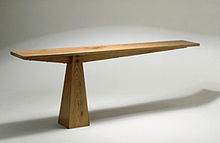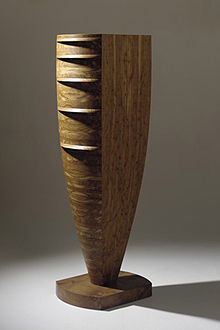- Matthew Burt
-
Matthew Burt (born 1951) is a furniture designer-maker in England who runs a contemporary practice from a studio and workshop (established 1978) based in the South Wiltshire village of Sherrington, west of Salisbury. His work has been displayed in significant public exhibitions, most notably in the OneTree touring show and at the House of Commons in 2008 in a selection of work intended to raise the profile of UK furniture making to Members of Parliament. His solo museum exhibition Idea to Object was held at the Crafts Study Centre, Farnham in 2008.
 Matthew Burt, Compass table-walnut. The table top shows ‘the journey through a tree’ made from workshop-sawn veneers in consecutive cuts through a tree. These are laid out in a radiating pattern demonstrating the timber’s beauty, whilst at the same time showing the way in which it grows. Top made of mirror-matched walnut veneers supported on a brickwork pedestal.
Matthew Burt, Compass table-walnut. The table top shows ‘the journey through a tree’ made from workshop-sawn veneers in consecutive cuts through a tree. These are laid out in a radiating pattern demonstrating the timber’s beauty, whilst at the same time showing the way in which it grows. Top made of mirror-matched walnut veneers supported on a brickwork pedestal.
Matthew Burt’s workshop steadily built on a reputation for furniture design that allies structurally robust work that fulfils its function with a lean, elegant line and the occasional bravura surface. Burt has said that he regards the ‘intermingling of science, engineering, mathematics, aesthetics and metaphorics’ as the fundamental building blocks for his furniture.[1]
He was awarded the Master’s Gold Award by the Worshipful Company of Furniture Makers in 2001. Peter Keen, Master of the Worshipful Company of Furniture Makers said: "I was delighted to see Matthew Burt receive his well-deserved award from the Lord Mayor. The table is a first class example of the very best in modern furniture design."[2]
 Matthew Burt, Canti-two sideboard-ash. Winning design for the Master’s Gold Award from the Worshipful Company of Furniture Makers and purchased for the Permanent Collection at the Crafts Study Centre, University for the Creative Arts this sideboard has a diagonally v-grooved surface to demonstrate that solid timber is beautiful all the way through.
Matthew Burt, Canti-two sideboard-ash. Winning design for the Master’s Gold Award from the Worshipful Company of Furniture Makers and purchased for the Permanent Collection at the Crafts Study Centre, University for the Creative Arts this sideboard has a diagonally v-grooved surface to demonstrate that solid timber is beautiful all the way through.
Contents
Biography
Born in 1951 in Wiltshire, Burt read Zoology at Reading University before studying furniture at Rycotewood College, Oxfordshire and then working as an apprentice to Richard Fyson in Gloucestershire. He established his own workshop in Wiltshire in 1978.
His degree in Zoology fed Burt’s inquisitive interest in the substructure of the natural world and he applied this interest in an innovative way to his earliest designs for furniture, sensing that the practical framework of his pieces could add both purpose and meaning to his designs. Crafts magazine has said: "Furniture maker Matthew Burt has a refreshingly no-nonsense approach to his work. He is a real maker’s maker with no time for conceptual craft and his love of what he calls the ‘magic that is making’ can be clearly seen in his current exhibition at Farnham’s Crafts Study Centre." [3]
Materials and design
Taking an approach of simplicity and honesty to his chosen materials (in the main, sustainable sources of English woods such as ash, oak, maple, cherry, sycamore, elm and walnut), Burt began his career designing within the idiom of Arts and Crafts furniture but adding contemporary notes such as elegantly bevelled edges and subtly cut-out sections to the top of tapered legs. His designs began to lose weight and added curves. He sought a playful contrast between restraint and elaboration, always aiming at technical perfection, in the manner of the designer-maker Alan Peters.
Major works
Burt works to commission although he has also designed pieces such as garden benches or public seating that can be made to order as ‘standard’ ranges. Some of his early commissions emphasised the playful dexterity of making wood do seemingly impossible things. A chair for an annual competition run by the arts development agency Southern Arts carried this exuberance to extremes, responding to a brief set by the organisation’s literature development officer to design and make a chair that has wit and speaks of its interest. Burt forced the idea of the essential framework or ‘exo-skeleton’ of a piece of furniture to the furthest point in his Ruminative Chair (1989) made of wych elm, English elm, burr elm and sycamore, replete with a floating seat pad, twisted stems, inlays, and moveable balls set at the ends of the arms, in a gothic-like seat. The chair was intended to make the impossible look plausible.
This chair is about as close to postmodernism as Burt allows himself to get. He has focused more recently on a cleanliness of line and, sometimes, a subtle and sinuous curve (for example in the complex edge of his Leaf Table (2007) or the Pyramalised dresser 1. These designs combine dexterity of hand skill with the advances made possible by computer assisted drawing technology. In Burt’s view, using sophisticated equipment as a means of advancing practice is both plausible and efficient. He may find a wistful and reflective admiration for the honest toil and tools of the Arts and Crafts furniture makers, but his work has to survive in a challenging contemporary marketplace, and the high prices that are charged for this commissioned work necessarily take into account high labour and studio costs as well as the intensive design and fitting stages of complex pieces for sometimes mercurial clients. Good Woodworking magazine wrote: "Today Matthew Burt is a recognised and well-respected brand, known for creating furniture that is neither gratuitously experimental or stagnantly nostalgic."[4]
The combination of clarity and complexity in Burt’s furniture was expressed in his award-winning Cantilevered Table, exhibited in the influential One Tree exhibition. Burt explained that this piece was "seemingly simple… relying on the intrinsic strength of the oak to span a long unsupported surface…’v-grooved’ to communicate the sensual and tactile delights of wood." [5]
Collections, commissions and honours
- Permanent collection of the Fitzwilliam Museum, Cambridge.
- Permanent collection of Crafts Study Centre, University for the Creative Arts.
- Public gallery seating for the Ashmolean Museum, Oxford.
- Private commissions for McLaren Group, the Institute of Directors, Balliol College and the offices of the Vice Chancellor and Deputy Vice Chancellor, University for the Creative Arts.
- Fellow of Royal Society of Arts.
- Member of the Devon Guild of Craftsmen.
- Fellow of the Society of Designer Craftsmen.
- Awarded the Master’s Gold Award by the Worshipful Company of Furniture Makers in 2001.
References
- ^ Olding, Simon. Matthew Burt: idea to object, Crafts Study Centre, 2008, p7
- ^ Keen, Peter. Makers News, The Worshipful Company of Furniture, July 2001, p5
- ^ ‘Up Front’, Crafts, Crafts Council, December 2008, p8
- ^ Loucaides, Darren, ‘Root & Branches’, Good Woodworking, April 2008, p27-33
- ^ Olson, Garry and Toiag, Peter. One Tree, Merrell, 2001, p46
External links
Categories:- People from Wiltshire
- English furniture designers
- Living people
- 1951 births
Wikimedia Foundation. 2010.



